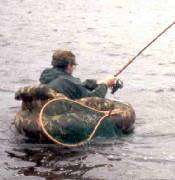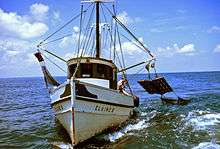Trident
A trident /ˈtraɪdənt/ is a three-pronged spear. It is used for spear fishing and historically as a polearm.
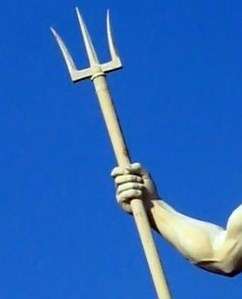
The trident is the weapon of Poseidon, or Neptune, the God of the Sea in classical mythology. The trident may occasionally be held by other marine divinities such as Tritons in classical art, and trident maybe depicted in medieval heraldry as well, sometimes held by a merman-Triton. In Hinduism, it is the weapon of Shiva, known as trishula (Sanskrit for "triple-spear").
Etymology
The word "trident" comes from the French word trident, which in turn comes from the Latin word tridens or tridentis: tri meaning "three" and dentes meaning "teeth", referring specifically to the three prongs, or "teeth", of the weapon.
The Greek equivalent is τρίαινα (tríaina), from Proto-Greek trianja, meaning "threefold". The Greek term does not imply three of anything specific, and is vague about the shape, thus the assumption it was originally of "trident" form has been challenged.[1]
Latin fuscina also means "trident".[2]
The Sanskrit name for the trident, trishula, is a compound of tri त्रि for "three" and śūla शूल for "thorn", calling the trident's three prongs "thorns" rather than "teeth".
Mythology and art
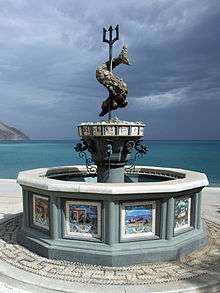
Poseidon
The trident is associated with the sea-god Poseidon and his Roman counterpart Neptune.
This divine instrument is said to have been forged by the cyclopes.[3]
Poseidon struck a rock with his trident, causing a sea (or a saltwater spring, called the Erechtheis) to appear nearby on the Acropolis in Athens.[4][5] And according to Roman sources, Neptune struck the earth with the trident to produce the first war-horse.[6]
Poseidon, as well as being the god of the sea, was also known as the "Earth Shaker",[7] believed to cause earthquakes;[8][lower-alpha 1] some commentator have extrapolated that the god would used the trident to cause them,[9] possibly by striking the earth.
In the Renaissance artist Gian Bernini's sculpture Neptune and Triton (1622–23), Neptune is posed holding a triton turned downwards, and is thought to reenact a scene from Aeneid or Ovid's Metamorphosis where he is calming the waves to aid Aeneas's ships.[10]
Other sea divinities
In later Greek and Roman art and literature, other sea deities and their attendants have been depicted holding the trident.
Poseidon's consort Amphitrite is often identified by some marine attribute other than a trident, which she never carries according to some scholars, though other commentators have disagreed.[11][13]
Turning to the retinue or a train of beings which follow the sea deities (the marine thiasos) the Tritons (mermen) may be seen bearing tridents.[14] Likewise, the Old Man of the Sea (halios geron) and the god Nereus are seen holding tridents.[14] Tritons, other mermen, and the Nereides can also carry rudders, oars, fish, or dolphins.[14]
Oceanus normally should not carry a trident, allowing him to be clearly distinguished from Poseidon. However, there is conflation of the deities in Romano-British iconography, and examples exist where the crab-claw headed Oceanus also bears a trident.[16][17] Oceanus holding a trident has been found on Romano-British coinage as well.[lower-alpha 2][18]
Some amorini have been depicted carrying tiny tridents.[lower-alpha 3][19]
The trident is even seen suspended like a pendant on a dolphin in Roman mosaic art.[lower-alpha 4][20]
Hindu mythology
In Hindu legends and stories Shiva, the Hindu god who holds a trishula trident in his hand, uses this sacred weapon to fight off negativity in the form of evil villains. The trident is also said to represent three gunas mentioned in Indian vedic philosophy namely sāttvika, rājasika, and tāmasika.
A weapon of South-East Asian (particularly Thai) depiction of Hanuman, a character of Ramayana.
Miscellaneous
In religious Taoism, the trident represents the Taoist Trinity, the Three Pure Ones. In Taoist rituals, a trident bell is used to invite the presence of deities and summon spirits, as the trident signifies the highest authority of Heaven.
A fork Jewish priests (Kohanim) used to take their portions of offerings.[21]
Classical uses
Fishing
In Ancient Greece, the trident was employed as a harpoon for spearing large fish, especially tunny-fishing.[22]
Combat
In Ancient Rome tridents (Latin: tridens or fuscina) were used by a type of gladiator called a retiarius or "net fighter". The retiarius was traditionally pitted against a secutor, and cast a net to wrap his adversary and then used the trident to kill him.[23][24]
Heraldry
In heraldry within the UK, the trident is often held by the figure identified as either a Neptune or a triton,[lower-alpha 5][25][26] or a merman.[lower-alpha 6][27]
The trident held up by an arm is depicted on some coats-of-arms.[28]
Modern-day uses
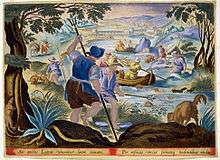
Spear-fishing
Tridents used in modern spear-fishing usually have barbed tines, which trap the speared fish firmly. In the Southern and Midwestern United States, gigging is used for harvesting suckers, bullfrogs, flounder and many species of rough fish.[29]
Agriculture
It has been used by farmers as a decorticator to remove leaves, seeds and buds from the stalks of plants such as flax and hemp.
Martial arts
The trident, known as dangpa, is used as a weapon in the 17th- to 18th-century systems of Korean martial arts.
Modern symbolism
The glyph or sigil of the planet Neptune, which alludes to the trident, is used in astronomy and astrology.
Political

- The Tryzub in the Coat of Arms of Ukraine, adopted in 1918 (in a reinterpretation of a medieval emblem which most likely depicted a skydiving falcon, like the Emblem of Staraya Ladoga)
- The national emblem on the flag of Barbados.
- The "forks of the people's anger", adopted by the Russian anti-Soviet revolutionary organization, National Alliance of Russian Solidarists (NTS).
- Britannia, the personification of Great Britain.
- The election symbol of the Communist Party of Nepal (United Marxist).[30]
Civilian use
- The symbol for Washington and Lee University.
- The symbol (since June 2008) for the athletic teams (Tritons) at the University of Missouri–St. Louis.
- Sparky the Sun Devil, the mascot of Arizona State University, holds a trident. (ASU recently redesigned its trident as a stand-alone symbol.)
- The trident was used as the original cap insignia and original logo for the Seattle Mariners.
- An element on the flag of the Sea Shepherd Conservation Society.
- The symbol for Washington and Lee University.
- The Maserati logo.
- Club Méditerranée.
- The Hawker Siddeley Trident, a 1960's British three-engine jet airliner.
- The Tirreno–Adriatico cycle race trophy.
Military emblems
- With Poseidon in the 31st Brigade.
- The symbol of the Swedish Coastal Rangers, Kustjägarna.
- The United States Naval Special Warfare Command, and the Special Warfare insignia, particularly worn by members of the US Navy SEALs, and containing a trident representing the three aspects (Sea, Air, and Land) of SEAL special operations.
- Part of the golden-colored crest of the United States Naval Academy, which depicts a trident running vertically in its background.
- The ship's crests of 13 of the 18 Ohio-class submarines of the U.S. Navy prominently feature tridents, as both a symbol of maritime power, and in reference to their payloads of Trident D-5 missiles.
- The rating badge of the United States Coast Guard Marine Science Technician.
- The Tug Banner used by Mongolian Honor guards.
- The insignia of the German commando force, Kampfschwimmer.
- The rating badge of the United States Navy Ocean Systems Technician (OT)
Botanical nomenclature
A number of structures in the biological world are described as trident in appearance. Since at least the late 19th century the trident shape was applied to certain botanical shapes; for example, certain orchid flora were described as having trident-tipped lips in early botanical works.[31] Furthermore, in current botanical literature, certain bracts are stated to have a trident-shape (e.g. Douglas-fir).[32]
Gallery
- A statue of Hindu God Shiva, holding a trishula, near Indira Gandhi International Airport, Delhi
 Two guardian deities of an ancient Chinese tomb, both holding tridents
Two guardian deities of an ancient Chinese tomb, both holding tridents- Trident, of Thailand, 18th century
_brought_as_offerings_to_Guna_Devi.%2C_near_Dharamsala%2C_Himachal_Pradesh.jpg)
See also
| Wikimedia Commons has media related to Tridents. |
Explanatory notes
- Mackay catalogs instances in classical literature where Poseidon is connected with the earthquake, but does not cite use of the trident in any, only mentioning its use in creating the horse.[8]
- The reverse side on the denarius of Carausius, acquired by the British Museum in 1998.
- Porta Capena mosaics, Rome. In the center is a square with geometric design (star inscribed in circle), and there are four diagonal spokes from it in the shape of a trident.
- Villa della Pisanella, Boscoreale, Italy.
- Burke assigns trident to Neptune and Eve to Triton. Eve states the Triton is "sometimes called Neptune", while Burke cross-references "merman" to "Neptune".
- Thomas Moule, among others write "triton, or merman" implying interchangeability of these terms.
References
- Citations
- Walters, H. B. (1892–1893), "Poseidon's Trident", The Journal of Hellenic Studies, 13 (37): 454, 459, 45
- Lewis, Charlton T.; Short, Charles, eds. (1879), "fuscina", A Latin Dictionary, Clarendon Press
- Pseudo-Apollodorus, Bibliotheke 1.2. Frazer tr. (1921), 1:11; text version via Perseus Project.
- Pseudo-Apollodorus, Bibliotheke 3.14. Frazer tr. (1921), 2:79 and note 2; text version via Perseus Project.
- Hurwit, Jeffrey M. (1999). The Athenian Acropolis: History, Mythology, and Archaeology from the Neolithic Era to the Present. Cambridge University Press. p. 32. ISBN 978-0-521-41786-0.
- Virgil, Georgics 1.12ff, apud Frazer tr. (1921), 2:79 and note 2
- Hesiod, Theogony 930.
- Mackay, L. A. (1946), "The Earthquake-Horse", Classical Philology, 41 (3): 150–154 JSTOR 267107
- Bury, John Bagnell (1940). "XXII.vi Zeus, Hera, Poseidon". The Cambridge Ancient History. University Press. p. 631.
Poseidon,..the earth-shaker, whose trident roused the earthquake, and the god of horses.
- Wilkins, Ann Thomas (2000), "Bernini and Ovid: Expanding the Concept of Metamorphosis", International Journal of the Classical Tradition, 6 (3): 403–404 JSTOR 30222585
- Collignon, Maxime (1890). Manual of Mythology: In Relation to Greek Art. Translated by Jane E. Harrison. H. Grevel & Co. pp. 197–199.
- Montfaucon, Bernard de (1724). Les Dieux Des Grecs Et Des Romains: Suppl. Delaulne. p. 70.; Pl. XXV
- The helmeted goddess bearing a trident has been identified as Amphitrite by Montfaucon in a carved carnelian in the collection of Maréchal d'Estrées.[12]
- Mylonopoulos (2009), pp. 188–189.
- "The Oceanus Mosaic". The British Museum.
- Oceanus Mosaic from Withington;[15] The "pavement from Ashcroft Villas, Cirencester" is also mentioned.
- Wilson, R. J. A. (2006), "Aspects of Iconography in Romano-British Mosaics: The Rudston 'Aquatic' Scene and the Brading Astronomer Revisited", Britannia, Society for the Promotion of Roman Studies, 37: 297–299 JSTOR 30030523
- Williams, J. H. C. (1999), "Septimius Severus and Sol, Carausius and Oceanus: two new Roman acquisitions at the British Museum", The Numismatic Chronicle (1966-), 159: 310–311 JSTOR 42668508
- Blake (1936), p. 149.
- Blake (1936), p. 139.
- "1 Samuel 2 / Hebrew Bible in English / Mechon-Mamre". mechon-mamre.org.
- Burkert, Walter (1985). The Athenian Acropolis: History, Mythology, and Archaeology from the Neolithic Era to the Present. Translated by Raffan, John. Harvard University Press. p. 137. ISBN 978-0-674-36281-9.
-

- Auguet, Roland [1970] (2012). Cruelty and Civilization: The Roman Games. London: Routledge. pp. 56–57, 72–74. ISBN 0-415-10452-1.
- Burke, Bernard (1864). merman, Neptune, trident. The General Armory of England, Scotland, Ireland, and Wales: Comprising a Registry of Armorial Bearings from the Earliest to the Present Time (2nd ed.). Harrison & sons. pp. xlii, xlvi.
- Eve, George W. (1907). "Heraldic birds and other figures". Heraldry as Art: An Account of Its Development and Practice, Chiefly in England. Batsford. p. 95.
- Moule, Thomas (1842). Heraldry of Fish: Notices of the Principal Families Bearing Fish in Their Arms. J. Van Voorst. p. 218.CS1 maint: ref=harv (link)
- Fox-Davies, Arthur Charles (1985). The Art of Heraldry: An Encyclopaedia of Armory. T.C. & E.C. Jack., p. 195 and Fig. 488, p. 396 Fig. 778 (p. 285)
- Turner, Andy. "Fish Gigging: An Ozark Tradition". Missouri Department of Conservation.
- पार्टीको सूची — Election Commission of Nepal Archived 2013-11-02 at the Wayback Machine
- John Lindley and Thomas Moore (1964) The Treasury of Botany: A Popular Dictionary of the Vegetable Kingdom with which is Incorporated a Glossary of Botanical Terms, Published by Longmans Green, pt.1
- C. Michael Hogan (2008) Douglas-fir: Pseudotsuga menziesii, globalTwitcher.com, ed. Nicklas Strõmberg Archived 2009-06-04 at the Wayback Machine
- "Iron-willed 'hero' images". nypost.com. 9 April 2010.
- Bibliography
- Blake, Marion Elizabeth (1936), "Roman Mosaics of the Second Century in Italy", Memoirs of the American Academy in Rome, Loeb classical library, New York: University of Michigan Press for the American Academy in Rome, 13, pp. 67–214 JSTOR 4238589
- Pseudo-Apollodorus (1921). Apollodorus: The Library. Loeb classical library. 1. Translated by J. G. Frazer. New York: G. P. Putnam's Sons.; Vol. 2
- Mylonopoulos, Joannis (2009). Odysseus with a trident? The Use of Attributes in Ancient Greek Imagery. Divine Images and Human Imaginations in Ancient Greece and Rome. BRILL. pp. 171–204. ISBN 978-9-047-44165-6.CS1 maint: ref=harv (link)

